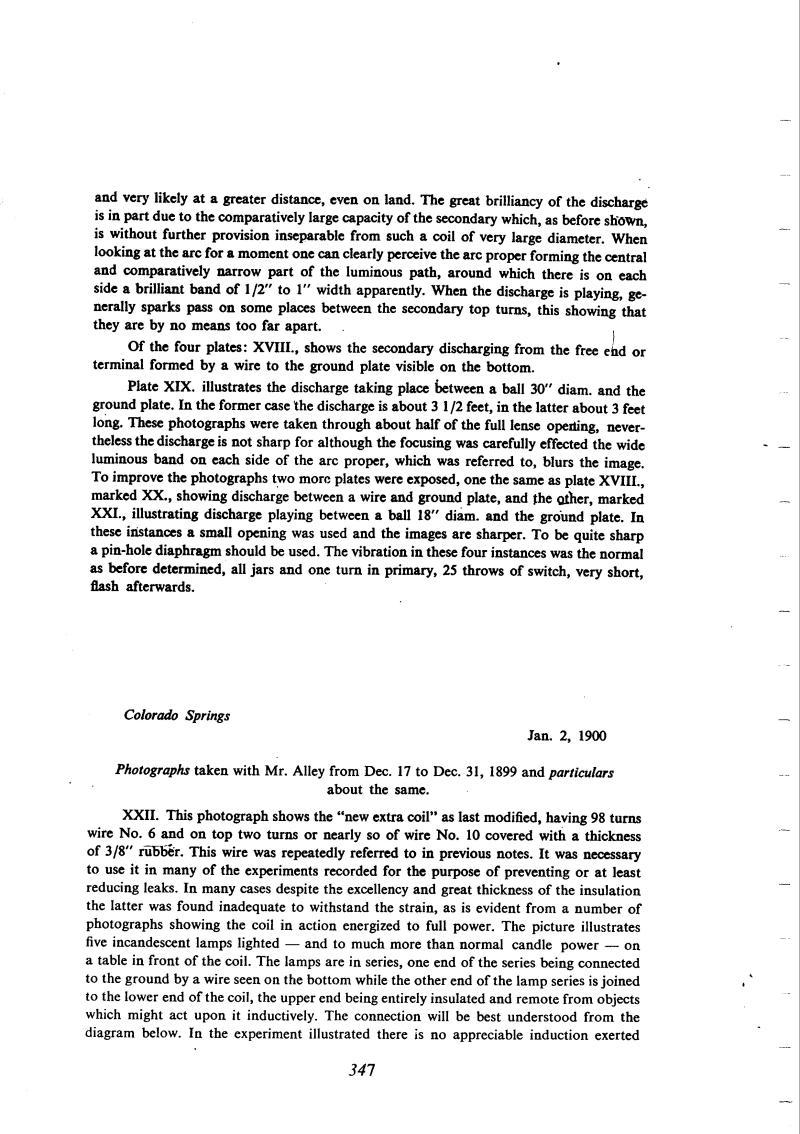
Nikola Tesla Books
January 1
On photograph XVII, bulbs are shown connected to the resonant circuit made of one turn rectangular in shape. According to data mentioned the square edge is 1.3 meters away from the oscillator secondary coil. The capacitance of the oscillating circuit consists of two capacitors connected in parallel. The bulbs are connected in parallel. The square turn inductance Tesla calculated according to an equation for two parallel conductors' inductance as those are two parallel conductors pairs connected in series. When the calculation is done as per equation for a square coil (Fleming, p. 155):
L = 81 (ln $! {d \over r} $! - 0.774)
The value obtained is 12.6% smaller than the one found in the notes. The calculated value of a square coil circuit resonant frequency is due to that somewhat higher, and therefore the inductance of the oscillator primary coil calculated as Tesla does it is even smaller. In fact, due to the existence of a very good coupled secondary the oscillator has complicated the oscillating spectrum with probably the strongest component in the frequency of the oscillating circuit with a square coil.
Related to four secondary coil photographs with extensive discharge the remark about energy transmission over a distance is interesting.
Tesla concluded on the basis of comparisons with achieved induction apparatus that the signal registration could be performed at the distance of 1000 or more miles, even over the earth globe surface. There is no data in the notes about measurements over longer distances, and in article(41) written immediately after the finish of the work at Colorado Springs, he says that he observed the effects at a distance of approximately 600 miles.
The explanation to Photograph XXII concerning the transmission of power from the excited primary circuit to the âextra coilâ via the earth is similar to that he gave in 1893(6). The experiment to which the photograph refers was made with the aim of estimating the power of the oscillator from the thermal effect of the HF current. What Tesla calls the âtotal energy set in movementâ would correspond to the total energy transferred to condenser in the secondary (i.e. the power) if an energy of $!{1 \over 2}$! CV2 is transferred in each half-cycle. It can be shown that the active power dissipated in the circuit is much less than this and is inversely proportional to the Q-factor of the oscillating circuit.
January 2
Tesla gave his observations on 22 pages. On them he described eleven photographs. The explanation along with photograph No. 22 about energy transmission from excitation of the primary circuit to "additional coil" over the earth surface is similar to the one from 1893(6). Otherwise the experiment to which the photograph is related was performed for the purpose of oscillator power estimate on the basis of thermal effects of high frequency current.
That which Tesla calls "total energy placed in motion" would correspond to the total energy which is supplied to a capacitor per second (i.e. power) if energy ½CV2 is supplied during the duration of one half of the period.
It could be shown that the active power which is spent in the circuit is considerably smaller than this power, and opposite, proportionally to the quality factor of the oscillating circuit. On several following photographs, the movable resonant coil with connected bulbs is photographed which is supplied by transmitted high frequency energy. One terminal of this coil is connected to the ground, and the other is open ended or a short piece of wire is connected to it. Bulbs are coupled by means of the auxiliary secondary coil inductively with the secondary coil. The data was not given on the distance of resonant coil from the oscillator coil. Tesla's comment on photograph No. 27 illustrates the interest on the question of electrical lightning, though he worked on this for more than ten years. One earlier discovery on gas elimination and not only filament, when working with high frequency currents is again proven(5).
On photograph No. 28 the bulb is connected in series with a terminal capacitance load. In the calculations "total energy placed in movement" is not taken when it was assumed that the electrostatic energy ½CV2 is spent in the bulb during one half of the period. A similar comment is valid for photograph No. 29.
Tesla mentioned several times that the main transmission from the exciting to the excited circuit is done via the ground. The proof for this statement he found in the experiment illustrated by photograph No. 30. He concluded that the induced voltage in the excited circuit is significantly reduced when the ground connection is disconnected. Photograph No. 31 is an X-ray photograph of a finger. The comments on this experiment are an illustration of Tesla's interest in the radiation field which was mentioned earlier (please see comment on June 6, 1899).

